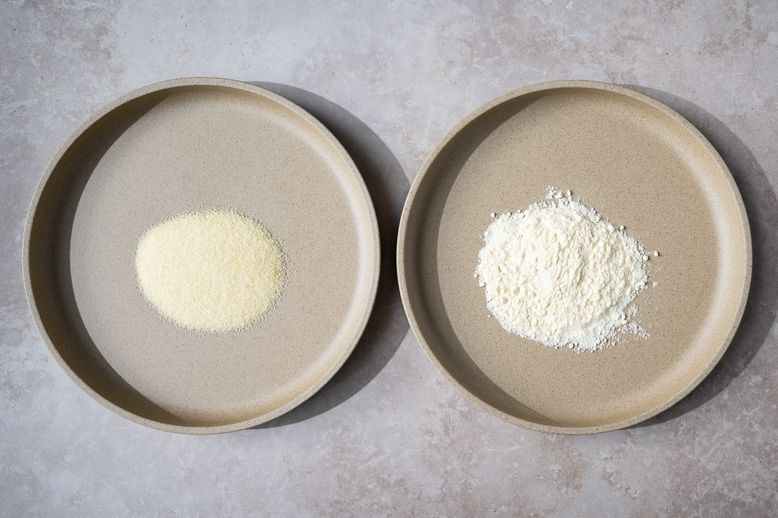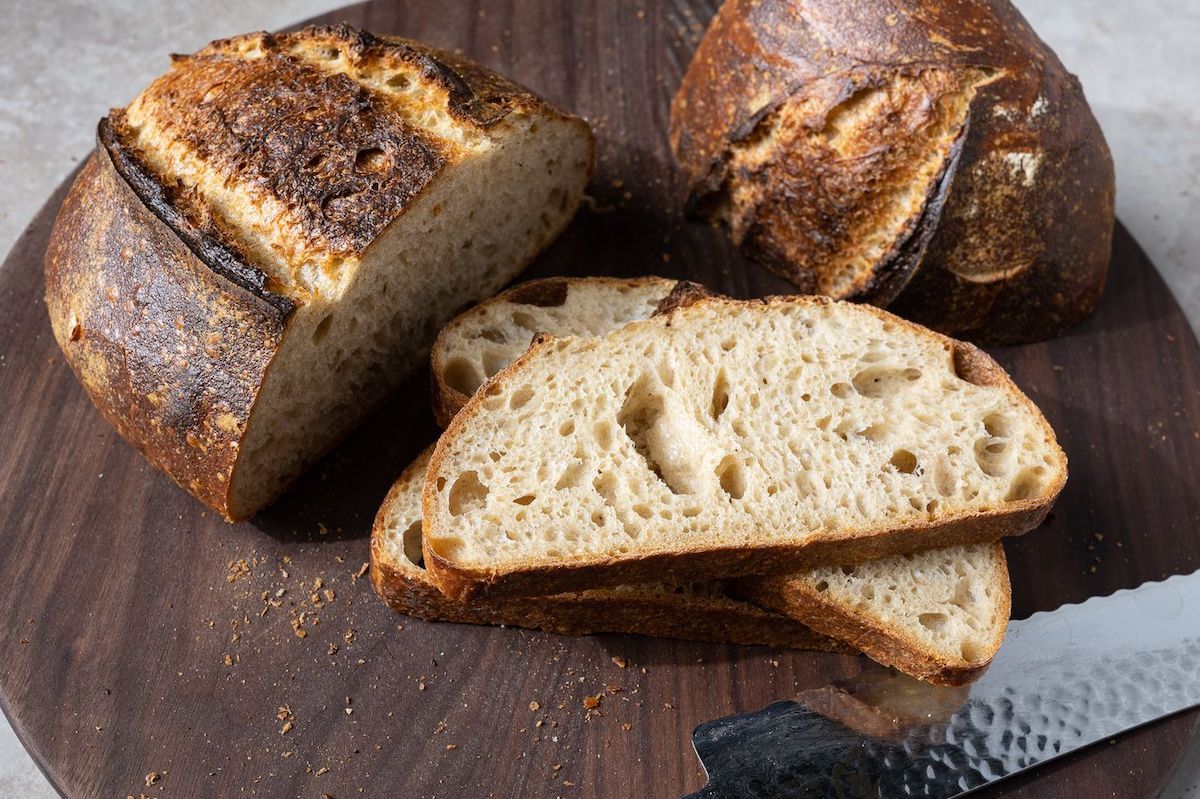The Perfect Loaf is a column from software engineer-turned-bread expert (and Food52's Resident Bread Baker), Maurizio Leo. Maurizio is here to show us all things naturally leavened, enriched, yeast-risen, you name it — basically, every vehicle to slather on a lot of butter. Today, how to turn high-protein durum flour into a golden loaf of bread.
* * *
If you're a fresh pasta-maker, chances are high you're familiar with durum wheat. Though the species is most commonly used to make pasta, it's also an excellent choice to incorporate into bread. It's a hard wheat — hence the name durum, which is Latin for "hard," — and is so-called because of the strength of the durum berry itself, requiring significant force to mill. The grain has a high protein percentage, but the gluten quality in durum flour doesn't have the same gas-trapping characteristics as traditional wheat. This means when using even finely-milled durum flour. The resulting bread will have a tighter, more cake-like crumb, or internal structure, somewhat akin to a loaf of whole wheat bread (as opposed to a super-light loaf with large inner holes, like a country loaf). Though there are visual and textural differences to a loaf of bread made durum wheat, there's no compromise made: The color, aroma, and flavors from durum are all quite striking when used in bread, yielding a more rustic loaf but nonetheless delicious.
I'm eager to share a few tips I've found helpful when using finely-milled durum wheat in bread-making. But first, let's clarify common source of confusion: If durum is typically used in pasta, what's the difference between durum flour for bread and semolina, the coarse durum wheat?
Durum flour versus semolina flour
You undoubtedly see packages of semolina at the market, with its grand yellow hue and sandy texture. Semolina is made from durum wheat, the same as durum flour. The difference between the two is mainly in texture: durum flour is very finely milled, whereas semolina is coarser-milled. If you rub semolina through your fingers, it feels more like beach sand or fine breadcrumbs; durum flour feels powdery-fine, like most other flours in your pantry.
Coarse semolina is primarily used in pasta-making, as it makes for a pliable, elastic, and easily workable dough that can be rolled, re-rolled, and cut. Were you to use this same coarse semolina in bread, you'd end up with a very gritty dough that doesn't entirely come together, and an extra-dense loaf.
Finding durum flour suitable for bread-making can be challenging, especially here in the U.S. However, more and more millers are now offering it in their lineup, and the flour can be ordered online from purveyors like King Arthur Baking Company, even in large quantities. Still, when sourcing durum flour for bread, be sure it's labeled explicitly "finely milled durum flour," "extra fancy durum wheat," or "semolina rimacinata" (which means twice-milled semolina).

Left: Semolina; Right: Durum flour, or semolina rimacinata. Photo by Maurizio Leo.
How to bake bread with finely-milled durum flour
Go all in, or blend with a traditional wheat
While it's possible to bake fantastic bread with 100 percent durum flour, my preference is to blend durum with traditional wheat in varying ratios. The benefit in blending, as is the case with loaves made with other combinations of flours, is you get the best of both worlds: a bread with more volume and an open interior than all-durum, but with the golden tint, sweet and nutty flavor, and aroma — somehow reminiscent of freshly-made pizza — that comes with using durum wheat.
After a bit of testing, my preferred sweet spot is 25 to 35 percent durum wheat to total flour in the recipe (for example, if there were 1000 grams of flour in the recipe, I'd suggest 250 to 350 grams durum). With this ratio, your loaf will have an amber-colored crust and yellow-hued crumb, but the loaf will be light, airy, and texturally satisfying to eat. In testing, I've pushed the durum up to 75 percent to total flour, which worked out just fine, but the resulting loaf was tighter inside, with a moist, but cake-like texture (but still very tasty!).
Increase the hydration
Bread dough with finely-milled durum wheat can typically take on more water than the equivalent quantity of traditional whole wheat flour. When developing my Rustic Italian Sourdough Bread recipe, I slowly increased the hydration percentage bake after bake until the dough felt sufficiently hydrated at the end of mixing.
When using durum wheat, expect that your dough may need more water than in a typical mix. But as always with dough hydration, be conservative and work up the added water amount slowly. A dough with a moderate to high percentage of durum can quickly go from feeling just right to over-hydrated, resulting in a loaf with a lackluster rise and a potentially gummy interior texture.
A longer autolyse
When using durum, you'll find your dough will typically be very strong and stiff. As a result of high protein content of the grain, and the characteristics of the proteins that make up durum itself, the dough will be firm and elastic. To help offset this, I usually perform a longer autolyse — which is simply allowing the flour and water in a dough recipe to rest before adding the salt and preferment, or levain — brings much-needed extensibility to the dough.
Think of extensibility as sort of the opposite of elasticity: Where an elastic dough is one that resists stretching, an extensible one stretches farther before snapping back or tearing. The dough's added extensibility helps it expand further during fermentation, giving space and openness to the loaf as it rises during fermentation.
While it's likely the increased extensibility is primarily due to the softening of the traditional wheat in the recipe rather than the durum itself, for such a simple step, it's an easy way to improve the volume of the final loaf of bread.
Embrace the rustic crust
A hallmark of using durum flour in bread is the crust's rustic charm, brought about by seemingly random fissures here and there on the loaf's exterior. When baked at a high temperature for longer, as I do in my Rustic Italian Sourdough recipe, the result will be a vivid, amber colored-crust contrasted by light golden splits at the areas where the dough is scored.
While I might typically see these splits as an issue with insufficient scoring depth or quantity, they fit in wonderfully with the overall aesthetic of this rustic bread. A loaf that begs to be torn by hand at the dinner table, with less pretension and more to the business of nourishment and flavor.
Mix gently
I like to think using durum is a way to channel bread-makers from an age before the advent of mechanical mixing. In my experience, while you could place the dough in a mechanical mixer for a few minutes, when the dough is mixed by hand, bread with a moderate percentage of durum wheat bakes off with a taller rise and lighter internal structure. Hand-mixing also ties in beautifully with the history of the grain itself, used for thousands of years to make all types of pasta and bread, all without mechanized assistance. Ultimately, durum flour helps create inherently rustic loaves that are as beautiful to look at as they are delicious.
Related reading:


Shares